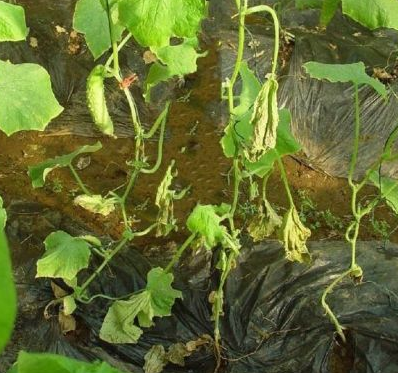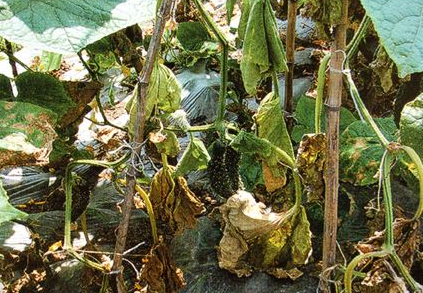Identification and control of cucumber wilt
Cucumber is the main vegetable variety cultivated by vegetable farmers. In recent years, due to the occurrence of cucumber wilt, the income of vegetable farmers has decreased. Among them, the incidence of cucumber in the greenhouse has become an important factor affecting the yield and benefit of cucumber, and prevention and control should be done in production. First, the symptoms and identification of hazards Cucumber wilt is a soil-borne disease, mainly invading the vascular bundle at the base of cucumber stems. The bacteria spread and spread in the vascular bundle. By blocking the vascular bundle conduit and secreting toxic substances to poison the host cells, the host normally absorbs the transport function and makes nutrients and water. Transshipment is blocked. Cucumber wilt can occur throughout the growth period, and the incidence is heavier after flowering, which is the most prosperous. The most typical symptom is wilting. The early stage of the disease is that the leaves gradually wilted from the bottom to the top. It seems to be lack of water. It is more obvious at noon. It can recover in the morning and evening. After a few days, the whole leaves will wither and sag, and will not return to normal. Often contracted, the roots are brown and rotten, the base of the stem is often longitudinally split, and the diseased stem is longitudinally examined, and the vascular bundle is brown. In wet conditions, the surface of the disease often produces a layer of white or pink mold. Second, the law of incidence Cucumber wilt is a fungal disease. Sprinkle with chlamydospores or mycelium in the soil and fertilizer with the diseased plant residues in the soil, or overwinter on unfertilized fertilizer or attached to seeds, greenhouses, and greenhouses. The bacteria can survive in the soil. ~6 years. When the conditions of the leap year are suitable, the initial infection is formed, and the conidia are produced in the diseased part, which can be spread by soil, seeds, fertilizer, agricultural tools and irrigation, and invade into the tissue of the cucumber cell by the root of the root, the root of the stem or the tip of the apex. And intracellular growth, and repeated reinfection. Later, it enters the vascular bundle, causing the plants to wilting, and even the whole plant is poisoned and died. The suitable soil temperature for the disease is 20 ° C ~ 23 ° C, below 15 ° C or higher than 35 ° C disease is inhibited. When the average temperature is 18 ° C ~ 25 ° C, relative humidity is higher than 85%, soil moisture is high, it is easy to develop. For continuous cropping, poorly drained clay land, or application of under-fertilized organic fertilizer, the root system of the plant is poorly developed, the weather is hot and humid, or the aging of the seedlings, the planting density is too large, and the nutrient-deficient plots are prone to disease. Third, comprehensive prevention and control technology 1. Choose resistant varieties. The resistance of cucumber varieties to Fusarium wilt was significantly different. Zhongnong 5,7,8, Jinchun 3 and other varieties are more resistant to disease and can be selected according to the situation. 2. Seed disinfection treatment. Soak seeds with warm water at about 55 ° C for 15 minutes, or use 50% carbendazim wettable powder for seed dressing at 0.1% by weight of the seed. 3. Pay attention to the arrangement of the mouth. Rotation and non-cucumber vegetables for more than three years can reduce the bacteria in the soil. 4. Pay attention to soil disinfection. Use disease-free soil seedlings, especially for seedling bed soil, to use seedlings that have not had blight. The dough was treated with 50% carbendazim per square meter. Before planting, use 50% carbendazim 2 kg per acre, mix 30 kg of fine dry soil, mix and spread evenly into the colonization hole. 5. Grafting to prevent disease. Grafting and disease prevention generally use black seed pumpkin as a rootstock to graft cucumber. Black seed pumpkin has developed root system, strong ability to absorb water and fertilizer, and strong growth potential. It has strong immunity to Fusarium wilt and has obvious effect on increasing yield. The grafting position of cucumber seedlings should be more than 2 cm from the ground, which can cut off the growth of adventitious roots. At the time of planting, the interface between the cucumber and the pumpkin must be at a certain height from the ground to avoid the cucumber from contacting the ground and then growing new roots, losing the effect of grafting and disease prevention. 6. Cover the roof to avoid rain and prevent diseases. After the temperature rises in the spring, the greenhouse retains the shed film and the skirt film. Usually, the skirt film is rolled up and the shed door is opened. When it rains, the skirt is closed and the shed door is closed to prevent rain and humidity and prevent soil such as melon wilt. Pass the disease. 7. Strengthen cultivation management. Implement soil testing and formula fertilization, and apply fully decomposed high-quality organic fertilizer. Pay attention to reducing wounds and improve the management level of cultivation during farming operations. Strictly prevent flooding and flooding, so that small water can be poured. Appropriate multi-cultivation, improve soil permeability, strengthen the root system and enhance disease resistance. Cucumber fruiting stage should be fertilized in stages, apply fully decomposed organic fertilizer, avoid using unfertilized human excrement and topdressing; increase application of cake fertilizer, phosphorus and potassium fertilizer and slaked lime to improve soil physical and chemical properties. The diseased plants are removed in time during the growth period. After harvesting, it is necessary to collect the residual diseased plants and burn them in a concentrated manner, and then turn over the ground to reduce the spread of blight. 8. Therapeutic root irrigation treatment in the early stage of the disease or before the onset of the disease. 50% carbendazim 500 times solution, 70% thiophanate-methyl + 50% carbendazim (1:1) 1000 times solution, 30% carbendazim 500-1000 times solution, 50% can be used before planting. % chlorobromo isocyanuric acid + nutritional agent 1500 ~ 2000 times liquid, agricultural anti-120 water agent 200 times liquid, etc., rooting around the plant, each hole 300 ~ 500 ml, can also spray the stem, but also can be used to coat the stem. Once every 5 to 7 days, 2 to 3 times in a row, the diseased plants should be watered around. Note that prevention and control of cucumber wilt must be early prevention and early treatment, otherwise the control effect is not good. Vegetable powder is a solid powder obtained by beating, filtering and spray drying bright vegetables. It has bright colors and delicious taste, and is a good helper for food additives and nutritional supplements. Natural Vegetable Powder,Rutin Powder,Sophora Japonica Extract,Dandelion Root Extract Powder Fufeng Sinuote Biotechnology Co.,Ltd. , https://www.sntextract.com

